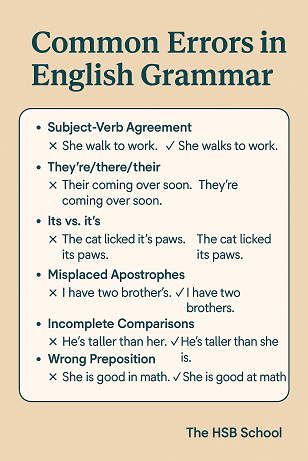Learn about the most frequent mistakes with our guide on “common errors in English grammar.” Improve your writing and speaking skills by avoiding these simple but crucial errors.

Making mistakes while learning English is normal. However, understanding the common errors in English grammar can help you speak and write more confidently. In this guide, we’ll highlight the most frequent mistakes and how you can easily fix them.
Common Errors in English Grammar
Let’s get started!
1. Subject-Verb Agreement Mistakes One of the most common errors in English grammar is incorrect subject-verb agreement.
Incorrect: She go to school every day.
Correct: She goes to school every day.
Always remember: singular subjects take singular verbs, and plural subjects take plural verbs.
2. Wrong Tense Usage Using the wrong tense can confuse your listener or reader.
Incorrect: I am finished my homework.
Correct: I have finished my homework.
Pay attention to whether you’re speaking about the past, present, or future.
3. Incorrect Preposition Usage Prepositions can be tricky, leading to common errors in English grammar.
Incorrect: She is married with a doctor.
Correct: She is married to a doctor.
Each verb often pairs with a specific preposition, so practice is key!
4. Confusion Between Similar Words Some words sound similar but have different meanings and uses.
Examples:
- Accept vs. Except
- Affect vs. Effect
- Their, There, They’re
Mastering these can help avoid confusing sentences.
5. Double Negatives Using two negatives in one sentence can make it confusing.
Incorrect: I don’t need no help.
Correct: I don’t need any help.
In English, two negatives cancel each other out, so use only one.
6. Misplaced Apostrophes Apostrophes are often misused, especially in possessives and contractions.
Incorrect: Its a beautiful day.
Correct: It’s a beautiful day.
Remember: “It’s” means “it is,” while “its” shows possession.
7. Run-on Sentences Connecting too many ideas without proper punctuation creates run-on sentences.
Incorrect: I love reading I read every night.
Correct: I love reading. I read every night.
Use periods or conjunctions to separate ideas clearly.
8. Using Adjectives Instead of Adverbs Adjectives describe nouns, while adverbs describe verbs.
Incorrect: She sings beautiful.
Correct: She sings beautifully.
Look for the action word and check if you need an adverb ending with “-ly.”
9. Incorrect Word Order In English, word order matters for clear communication.
Incorrect: Always she is late.
Correct: She is always late.
The usual order is Subject + Verb + Object, with adverbs placed carefully.
10. Forgetting to Use Articles Articles like “a,” “an,” and “the” are important but often forgotten.
Incorrect: I bought umbrella.
Correct: I bought an umbrella.
Use “a” or “an” for general items and “the” for specific ones.
Final Thoughts Understanding and avoiding these common errors in English grammar will instantly make your English sound more natural and polished. Practice every day, read carefully, and don’t be afraid to make mistakes—they’re part of the learning journey!
With a little effort, you’ll soon notice a big difference in your communication skills.
Would you also like me to create a quick infographic or social media post summarizing these common errors? 😊
Please checkout English Grammar Rules
